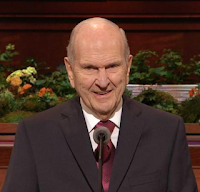My arm is still sore, but it’s a reminder that “prevention is better than cure.” It’s an obvious metaphor for how “good information,” even if painful at first, can prevent serious problems later on.
| “Good inspiration is based upon good information.” |
I often think about what President Nelson said in April 2018, his first General Conference as President of the Church:
“I know that good inspiration is based upon good information.“
Let’s consider what is “good information.”
“Good information” is surely “important information” we need to make informed decisions.
One thing we can be sure of: “good information” does not consist of “no information” or “censored information.”
_____
This morning I was reviewing and annotating a letter Joseph Smith wrote to W.W. Phelps in 1832. (This is part of a Church History project I’m working on.)
Here’s a link:
https://www.josephsmithpapers.org/paper-summary/letter-to-william-w-phelps-31-july-1832/1
In that letter, Joseph wrote this:
the spirit which I possess enjoy, the feeling of my soul enquires does this letter give me the important information which I stood in need of at the present critical moment from your hand concerning yourself your family & business & the faith & fellowship & prosperity of the brethren in zion &c
I find this interesting in today’s world where Church employees and departments are censoring information at various levels. I’ve been informed about instances in which they are even depriving Church leaders and members of important information and perspectives. One example was the first published draft of the Gospel Topics Essay on Book of Mormon Geography.*
_____
In light of all this, and with Joseph’s letter to Phelps in mind, consider this:
We should all ask ourselves, does the information we receive “give us the important information which we stand in need of at the present critical moment?”
If not, we owe it to ourselves to ask why not.
What important information do you need?
We can’t make informed decisions without good information. According to President Nelson, we can’t even get good inspiration without good information.
Joseph Smith himself recognized this when he complained to Phelps for not sending “important information” he needed.
_____
This blog focuses on Book of Mormon geography.
It may surprise some people, but this isn’t a topic I spend a lot of time on. However, I think it’s critically important because it has implications for other topics.
It’s also an area in which we can all observe agenda-driven censorship that deprives us of “good information” and “important information.”
_____
By now, it’s apparent to everyone that the dominant intellectuals in the Church have established and enforced their views through censorship. This is particularly true of the M2C citation cartel** and the Church History Department. Both groups deprive members of the Church of “good information” solely to promote their particular agendas.
Two specific examples are the censorship in the Joseph Smith lesson manual and in the Saints book. (You can click on those links to see more detail.) There are many more examples, only a few of which I’ve shown on this blog and elsewhere.
An easy remedy for the Cumorah issue would be to provide all students in CES and BYU with my proposed BYU packet, which is available here:
http://www.lettervii.com/p/byu-packet-on-cumorah.html
Instead, few if any CES/BYU students ever learn about these teachings. Many of their teachers don’t even know about them.
I’m not saying anyone has to believe or accept these teachings. It’s not a question of prophetic or Church support for anyone’s ideas.
What I’m saying is, no one can make an informed decision without at least considering these teachings.
The M2C intellectuals know about these teachings but they don’t inform their followers about them. To the extent they address these teachings, they dismiss them as unreliable and wrong. Then they conflate them with separate teachings about how we don’t know the specific locations of Book of Mormon locations other than Cumorah, and the even less relevant teachings about the locations of modern Lamanites (which of course has nothing to do with the location of Book of Mormon events).
And that’s all fine. They can put whatever spin they want on the source materials.
But they should let their students and followers make informed decisions by providing this “good information” instead of censoring this “good information” purely to protect their own M2C ideology.
I encourage everyone who has or knows a student in Seminary, Institute, a BYU campus, or even in Gospel Doctrine class to share this “BYU packet” so people can make informed decision based on “good information.”
Who knows? Maybe, as President Nelson taught, some “good inspiration” might come from it.
_____
*The first published draft of the Gospel Topics Essay on Book of Mormon Geography* quoted President Ivins out of context, without also quoting his specific remarks on Cumorah, which I discussed here:
https://presidentnelsonspeaks.blogspot.com/2019/02/revisions-to-gospel-topics-essay-on.html
It’s fascinating that the revised essay deleted the President Ivins quotation. I discussed that here:
http://bookofmormonwars.blogspot.com/2019/02/great-news-revised-gospel-topics-essay.html
** The M2C citation cartel is the group of scholars (and their followers and employees) who promote the Mesoamerican/two-Cumorahs theory of Book of Mormon geography. The cartel includes BYU Studies, Book of Mormon Central, the Interpreter, FairMormon, Meridian Magazine, many prominent blogs, and others.
Source: Book of Mormon Wars
